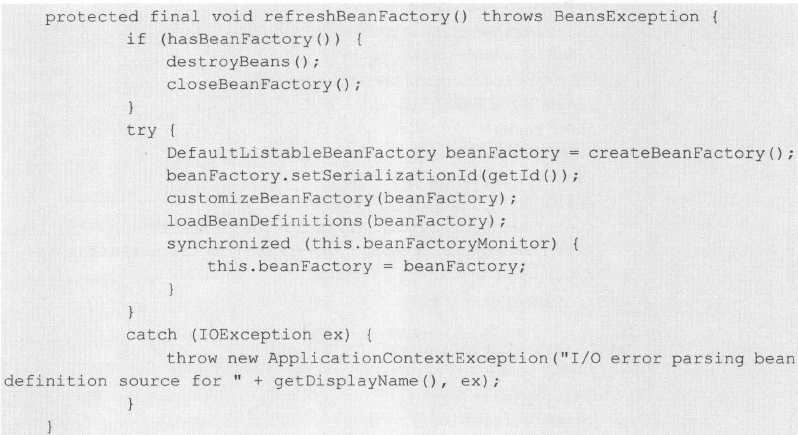IOC容器是什么?
(转http://www.cnblogs.com/lihuiyy/archive/2012/05/22/2512712.html)
Spring的IoC容器就是一个实现了BeanFactory接口的可实例化类。事实上,Spring提供了两种不同的容器:一种是最基本的BeanFactory,另一种是扩展的ApplicationContext。BeanFactory 仅提供了最基本的依赖注入支持,而 ApplicationContext 则扩展了BeanFactory ,提供了更多的额外功能。实例化这两种容器时是有区别的:
(1)BeanFactory
XmlBeanFactory bFactory = new XmlBeanFactory(new ClassPathResource("Spring.xml"));获取某个类的实例时如下:
BeansDemoClass beans = (BeansDemoClass) bFactory.getBean("beansDemoClass");(2)ApplicationContext
ApplicationContext aContext = new ClassPathXmlApplicationContext("Spring.xml");
BeansDemoClass bDemoClass = (BeansDemoClass)aContext.getBean("beansDemoClass");二者对Bean的初始化也有很大区别。BeanFactory当需要调用时读取配置信息,生成某个类的实例。如果读入的Bean配置正确,则其他的配置中有错误也不会影响程序的运行。而ApplicationContext 在初始化时就把 xml 的配置信息读入内存,对 XML 文件进行检验,如果配置文件没有错误,就创建所有的Bean ,直接为应用程序服务。相对于基本的BeanFactory,ApplicationContext 唯一的不足是占用内存空间。当应用程序配置Bean较多时,程序启动较慢。
如何构建BeanFactory
Ioc容器实际上是Context组件结合其他两个组件共同构建了一个Bean关系网。构建Ioc容器的入口在于AbstractApplicationContext类(org.springframework.context.support)的refresh方法中。方法如下:
@Override
public void refresh() throws BeansException, IllegalStateException {
synchronized (this.startupShutdownMonitor) {
// Prepare this context for refreshing.
prepareRefresh();
// Tell the subclass to refresh the internal bean factory.
ConfigurableListableBeanFactory beanFactory = obtainFreshBeanFactory();
// Prepare the bean factory for use in this context.
prepareBeanFactory(beanFactory);
try {
// Allows post-processing of the bean factory in context subclasses.
postProcessBeanFactory(beanFactory);
// Invoke factory processors registered as beans in the context.
invokeBeanFactoryPostProcessors(beanFactory);
// Register bean processors that intercept bean creation.
registerBeanPostProcessors(beanFactory);
// Initialize message source for this context.
initMessageSource();
// Initialize event multicaster for this context.
initApplicationEventMulticaster();
// Initialize other special beans in specific context subclasses.
onRefresh();
// Check for listener beans and register them.
registerListeners();
// Instantiate all remaining (non-lazy-init) singletons.
finishBeanFactoryInitialization(beanFactory);
// Last step: publish corresponding event.
finishRefresh();
}
catch (BeansException ex) {
if (logger.isWarnEnabled()) {
logger.warn("Exception encountered during context initialization - " +
"cancelling refresh attempt: " + ex);
}
// Destroy already created singletons to avoid dangling resources.
destroyBeans();
// Reset 'active' flag.
cancelRefresh(ex);
// Propagate exception to caller.
throw ex;
}
finally {
// Reset common introspection caches in Spring's core, since we
// might not ever need metadata for singleton beans anymore...
resetCommonCaches();
}
}
}首先说说try{}块之前的语句。
先进行了BeanFactory(下面叫BF)的创建和配置,当BF已经存在时就更新,如果不存在就创建。
obtainFreshBeanFactory() -> refreshBeanFactory()【是一个抽象方法】
代码中,loadBeanDefinition(beanfactory)这个方法将加载、解析Bean的定义,也就是把用户定义的数据结构转化为IOC容器中的特定数据结构。
prepareBeanFactory的作用就是为工厂配置标准的上下文的属性。
/**
* Configure the factory's standard context characteristics,
* such as the context's ClassLoader and post-processors.
* @param beanFactory the BeanFactory to configure
*/
protected void prepareBeanFactory(ConfigurableListableBeanFactory beanFactory) {
// Tell the internal bean factory to use the context's class loader etc.
beanFactory.setBeanClassLoader(getClassLoader());
beanFactory.setBeanExpressionResolver(new StandardBeanExpressionResolver(beanFactory.getBeanClassLoader()));
beanFactory.addPropertyEditorRegistrar(new ResourceEditorRegistrar(this, getEnvironment()));
// Configure the bean factory with context callbacks.
beanFactory.addBeanPostProcessor(new ApplicationContextAwareProcessor(this));
beanFactory.ignoreDependencyInterface(ResourceLoaderAware.class);
beanFactory.ignoreDependencyInterface(ApplicationEventPublisherAware.class);
beanFactory.ignoreDependencyInterface(MessageSourceAware.class);
beanFactory.ignoreDependencyInterface(ApplicationContextAware.class);
beanFactory.ignoreDependencyInterface(EnvironmentAware.class);
// BeanFactory interface not registered as resolvable type in a plain factory.
// MessageSource registered (and found for autowiring) as a bean.
beanFactory.registerResolvableDependency(BeanFactory.class, beanFactory);
beanFactory.registerResolvableDependency(ResourceLoader.class, this);
beanFactory.registerResolvableDependency(ApplicationEventPublisher.class, this);
beanFactory.registerResolvableDependency(ApplicationContext.class, this);
// Detect a LoadTimeWeaver and prepare for weaving, if found.
if (beanFactory.containsBean(LOAD_TIME_WEAVER_BEAN_NAME)) {
beanFactory.addBeanPostProcessor(new LoadTimeWeaverAwareProcessor(beanFactory));
// Set a temporary ClassLoader for type matching.
beanFactory.setTempClassLoader(new ContextTypeMatchClassLoader(beanFactory.getBeanClassLoader()));
}
// Register default environment beans.
if (!beanFactory.containsLocalBean(ENVIRONMENT_BEAN_NAME)) {
beanFactory.registerSingleton(ENVIRONMENT_BEAN_NAME, getEnvironment());
}
if (!beanFactory.containsLocalBean(SYSTEM_PROPERTIES_BEAN_NAME)) {
beanFactory.registerSingleton(SYSTEM_PROPERTIES_BEAN_NAME, getEnvironment().getSystemProperties());
}
if (!beanFactory.containsLocalBean(SYSTEM_ENVIRONMENT_BEAN_NAME)) {
beanFactory.registerSingleton(SYSTEM_ENVIRONMENT_BEAN_NAME, getEnvironment().getSystemEnvironment());
}
}然后是这三句
// Allows post-processing of the bean factory in context subclasses.
postProcessBeanFactory(beanFactory);
// Invoke factory processors registered as beans in the context.
invokeBeanFactoryPostProcessors(beanFactory);
// Register bean processors that intercept bean creation.
registerBeanPostProcessors(beanFactory);这三行代码对Spring的功能扩展性起了重要的作用。前两行主要是让我们现在可以已经创建的BF的配置做修改,后面一行就让你可以对以后再创建Bean的实例对象时添加一些自定义的操作。
我们分别看看他的方法说明
postProcessBeanFactory这个方法作用就是允许我们在context内部的BF初始化之后,我们对其进行修改。
/**
* Modify the application context's internal bean factory after its standard
* initialization. All bean definitions will have been loaded, but no beans
* will have been instantiated yet. This allows for registering special
* BeanPostProcessors etc in certain ApplicationContext implementations.
* @param beanFactory the bean factory used by the application context
*/
protected void postProcessBeanFactory(ConfigurableListableBeanFactory beanFactory) {
}实例化和唤醒所有注册了的BeanFactoryPostProcessor类型的beans。
/**
* Instantiate and invoke all registered BeanFactoryPostProcessor beans,
* respecting explicit order if given.
* <p>Must be called before singleton instantiation.
*/
protected void invokeBeanFactoryPostProcessors(ConfigurableListableBeanFactory beanFactory) {
PostProcessorRegistrationDelegate.invokeBeanFactoryPostProcessors(beanFactory, getBeanFactoryPostProcessors());
// Detect a LoadTimeWeaver and prepare for weaving, if found in the meantime
// (e.g. through an @Bean method registered by ConfigurationClassPostProcessor)
if (beanFactory.getTempClassLoader() == null && beanFactory.containsBean(LOAD_TIME_WEAVER_BEAN_NAME)) {
beanFactory.addBeanPostProcessor(new LoadTimeWeaverAwareProcessor(beanFactory));
beanFactory.setTempClassLoader(new ContextTypeMatchClassLoader(beanFactory.getBeanClassLoader()));
}
}/**
* Instantiate and invoke all registered BeanPostProcessor beans,
* respecting explicit order if given.
* <p>Must be called before any instantiation of application beans.
*/
protected void registerBeanPostProcessors(ConfigurableListableBeanFactory beanFactory) {
PostProcessorRegistrationDelegate.registerBeanPostProcessors(beanFactory, this);
}后面几行是监听
如何创建Bean实例并构建Bean的关系网
Bean的实例化从这句开始。 finishBeanFactoryInitialization(beanFactory);
/**
* Finish the initialization of this context's bean factory,
* initializing all remaining singleton beans.
*/
protected void finishBeanFactoryInitialization(ConfigurableListableBeanFactory beanFactory) {
// Initialize conversion service for this context.
if (beanFactory.containsBean(CONVERSION_SERVICE_BEAN_NAME) &&
beanFactory.isTypeMatch(CONVERSION_SERVICE_BEAN_NAME, ConversionService.class)) {
beanFactory.setConversionService(
beanFactory.getBean(CONVERSION_SERVICE_BEAN_NAME, ConversionService.class));
}
// Register a default embedded value resolver if no bean post-processor
// (such as a PropertyPlaceholderConfigurer bean) registered any before:
// at this point, primarily for resolution in annotation attribute values.
if (!beanFactory.hasEmbeddedValueResolver()) {
beanFactory.addEmbeddedValueResolver(new StringValueResolver() {
@Override
public String resolveStringValue(String strVal) {
return getEnvironment().resolvePlaceholders(strVal);
}
});
}
// Initialize LoadTimeWeaverAware beans early to allow for registering their transformers early.
String[] weaverAwareNames = beanFactory.getBeanNamesForType(LoadTimeWeaverAware.class, false, false);
for (String weaverAwareName : weaverAwareNames) {
getBean(weaverAwareName);
}
// Stop using the temporary ClassLoader for type matching.
beanFactory.setTempClassLoader(null);
// Allow for caching all bean definition metadata, not expecting further changes.
beanFactory.freezeConfiguration();
// Instantiate all remaining (non-lazy-init) singletons.
beanFactory.preInstantiateSingletons();
}直接看最后一句,
// Instantiate all remaining (non-lazy-init) singletons.
beanFactory.preInstantiateSingletons();preInstantiateSingletons方法中出现一个非常重要的Bean–FactoryBean,他是个工厂Bean,可以产生Bean实例的Bean。不同于普通Bean的是:它是实现了FactoryBean接口的Bean,根据该Bean的Id从BeanFactory中获取的实际上是FactoryBean的getObject()返回的对象,而不是FactoryBean本身, 如果要获取FactoryBean对象,可以在id前面加一个&符号来获取。SpringAOP也可以通过这个方法来实现。具体例子看参看下面的网址<本段转自:http://blog.csdn.net/is_zhoufeng/article/details/38422549>























 906
906

 被折叠的 条评论
为什么被折叠?
被折叠的 条评论
为什么被折叠?








